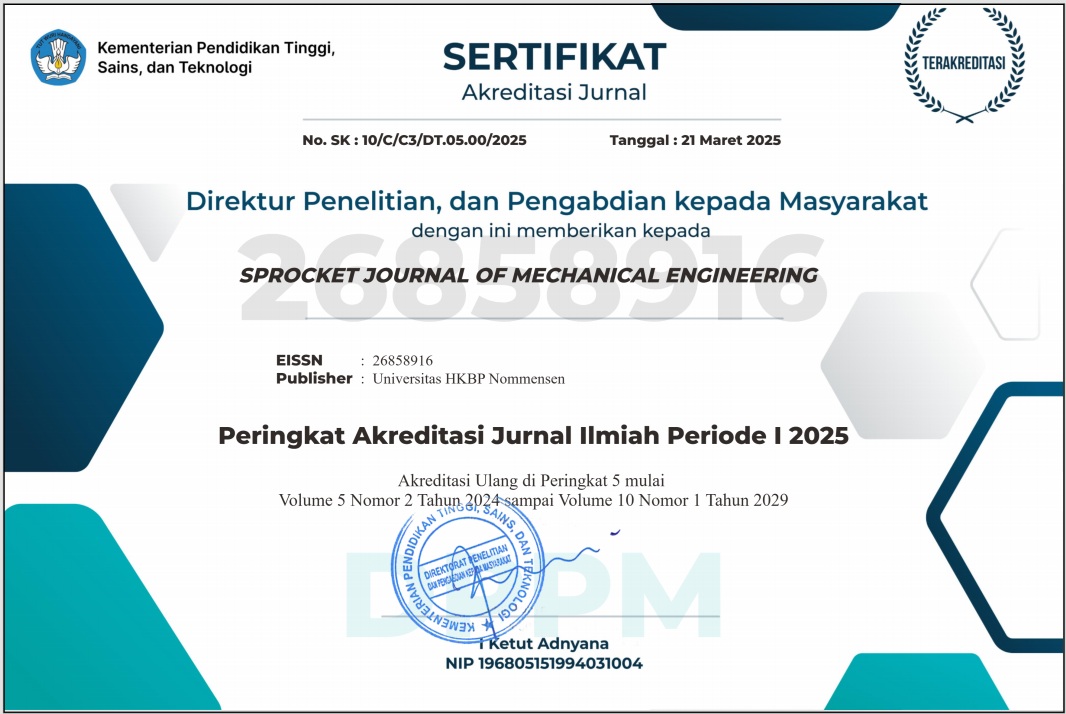Upaya Pereduksian Emisi Karbon Dioksida (CO2) di Indonesia melalui Analisis Integrasi Power-to-Gas dengan PLTU Batubara
Abstract
Sektor pembangkit listrik sebagai punggung utama energi nasional masih didominasi oleh bahan bakar fosil khususnya batubara. Emisi gas karbon dioksida (CO2) yang dihasilkan dari proses pembakaran batubara menimbulkan banyak dampak buruk pada bidang lingkungan dan kesehatan masyarakat. Sebagai upaya reduksi emisi CO2 yang dihasilkan, Power-to-Gas (PtG) menawarkan solusi yang efektif guna mengatasi masalah emisi dengan mengubahnya menjadi energi. Sistem PtG terdiri dari proses carbon capture (penangkapan karbon), elektrolisis dan metanasi. Melalui sistem PtG, emisi CO2 dari PLTU (Pembangkit Listrik Tenaga Uap) dapat diubah menjadi gas metana (CH4) dalam bentuk syngas (gas sintesis). Metode pada studi ini adalah memetakan sebaran PLTU Indonesia di tahun 2021, memperkirakan emisi CO2 dan mereduksinya melalui carbon capture, serta menghitung estimasi produksi syngas. Estimasi emisi CO2 dari PLTU mencapai 62,5 juta ton dan mampu direduksi hingga 28,15 juta ton melalui pengintegrasian sistem PtG. Perolehan syngas diperkirakan mencapai 0,255 TSCF (Triliun Standard Cubic Feet) atau setara dengan 0,614% dari total cadangan gas alam Indonesia. Integrasi sistem PtG dengan PLTU batubara di Indonesia memiliki prospek yang menjanjikan dan memberikan peluang kajian lebih lanjut untuk mengenai pengembangannya.
The electricity generation sector, which is the backbone of national energy, is still dominated by fossil fuels, especially coal. The carbon dioxide (CO2) emissions resulting from the combustion of coal have many adverse effects on the environment and public health. To reduce CO2 emissions, Power-to-Gas (PtG) offers an effective solution to convert them into energy. The PtG system consists of carbon capture, electrolysis, and methanation processes. This system can convert CO2 emissions from coal-fired power plants into methane gas (CH4) in the form of syngas. The methodology used in this study involves mapping the distribution of Indonesian coal-fired power plants in 2021, estimating their CO2 emissions, reducing them through carbon capture, and calculating the estimated syngas production. The estimated CO2 emissions from the PLTU reach 62.5 million tonnes and can be reduced by up to 28.15 million tonnes through the integration of PtG systems. The acquisition of syngas is estimated to reach 0.255 TSCF (Trillion Standard Cubic Feet), or equivalent to 0.614% of Indonesia's total natural gas reserves. The integration of PtG systems with coal-fired power plants in Indonesia has promising prospects and provides opportunities for further study on its development.
References
[2] Ministry of Energy and Mineral Resources Republic of Indonesia, Handbook of energy and economic statistics of Indonesia 2022. Jakarta: Ministry of Energy and Mineral Resources Republic of Indonesia, 2022. [Online]. Available: https://www.esdm.go.id/assets/media/content/content-handbook-of-energy-and-economic-statistics-of-indonesia-2022.pdf
[3] H. Ritchie, P. Rosado, and M. Roser, “CO₂ and greenhouse Gas emissions.” [Online]. Available: https://ourworldindata.org/co2-and-greenhouse-gas-emissions#co2-and-greenhouse-gas-emissions-country-profiles
[4] M. Haug, “IEA, world energy investment outlook and the prospects for carbon capture and storage,” in Conference: greenhouse gas control technologies, Canada: Vancouver, 2004.
[5] Intergovernmental Panel on Climate Change, Carbon dioxide capture and storage. United States of America: Intergovernmental Panel on Climate Change, 2005. [Online]. Available: https://www.ipcc.ch/site/assets/uploads/2018/03/srccs_wholereport-1.pdf
[6] D. A. Sari, E. Purba, and D. Supriyadi, “Kemampuan penyerapan CO2 menggunakan Tetraselmis chuii terhadap intensitas cahaya,” techno, vol. 19, no. 1, pp. 45–50, May 2018, doi: 10.30595/techno.v19i1.2345.
[7] H. Hadiyanto, S. Sumarno, R. Nur Rostika, and N. Abyor Handayani, “Biofixation of carbon dioxide by Chlamydomonas sp. in a tubular photobioreactor,” International Journal of Renewable Energy Development, vol. 1, no. 1, pp. 10–14, Feb. 2012, doi: 10.14710/ijred.1.1.10-14.
[8] G. N. Fadhillah and D. A. Sari, “Produksi biodiesel yang berbahan baku kelapa sawit dengan melibatkan katalis homogen dan heterogen,” Pena: Jurnal Ilmu Pengetahuan dan Teknologi, vol. 37, no. 2, pp. 87–94, 2023, doi: 10.31941/jurnalpena.v37i2.2484.
[9] Y. Wahyono and H. Hadiyanto, “Life cycle assessment of biodiesel production from crude palm oil: A case study of three Indonesian biodiesel plants,” IOP Conference Series: Earth and Environmental Science, vol. 348, no. 012002, pp. 1–7, 2019, doi: 10.1088/1755-1315/348/1/012002.
[10] R. Y. Naulina et al., Kimia industri. Bandung: Penerbit Widina Media Utama, 2023. [Online]. Available: https://repository.penerbitwidina.com/media/publications/563628-kimia-industri-64fe6020.pdf
[11] Q. Ayun et al., Kimia organik. Bandung: Penerbit Widina Bhakti Persada Bandung, 2023. [Online]. Available: https://repository.penerbitwidina.com/media/publications/559158-kimia-organik-894999a4.pdf
[12] D. A. Sari et al., Top 33 chemical engineering essay competition (part 1). Tasikmalaya: Perkumpulan Rumah Cemerlang Indonesia, 2021. [Online]. Available: https://www.researchgate.net/publication/358356753_Top_33_Chemical_engineering_essay_competition_part_1
[13] M. Thema, F. Bauer, and M. Sterner, “Power-to-Gas: Electrolysis and methanation status review,” Renewable and Sustainable Energy Reviews, vol. 112, pp. 775–787, 2019, doi: 10.1016/j.rser.2019.06.030.
[14] S. Sansuadi and R. C. Nugroho, Statistik ketenagalistrikan tahun 2021. Jakarta: Sekretariat Direktorat Jenderal Ketenagalistrikan, 2021. [Online]. Available: https://gatrik.esdm.go.id/assets/uploads/download_index/files/6e4c6-statistik-2021-rev-2-.pdf
[15] A. C. Adi and F. Lasnawatin, Handbook of energy and economic statistics of Indonesia 2021. Jakarta: Ministry of Energy and Mineral Resources Republic of Indonesia, 2021. [Online]. Available: https://www.esdm.go.id/assets/media/content/content-handbook-of-energy-and-economic-statistics-of-indonesia-2021.pdf
[16] Tim Penulisan Direktorat Teknik dan Lingkungan Ketenagalistrikan, “Pedoman perhitungan dan pelaporan inventarisasi gas rumah kaca: bidang energi - sub bidang ketenagalistrikan.” Direktorat Jenderal Ketenagalistrikan Kementerian ESDM, 2018. [Online]. Available: https://apple-gatrik.esdm.go.id/public/pdf/Pedoman_Penghitungan_dan_Inventarisasi_GRK_Sub_Bidang_Ketenagalistrikan%20_Revisi_Jan_2019.pdf
[17] A. Sagala, “Petunjuk teknis gas rumah kaca (GRK) di sektor industri.” Badan Pengkajian Kebijakan Iklim dan Mutu Industri, 2012. [Online]. Available: https://drive.google.com/file/d/18uSgRO4pLN0IxVDqztcYQCfRJcpQgz52/view?usp=drive_link
[18] J. Gao et al., “A thermodynamic analysis of methanation reactions of carbon oxides for the production of synthetic natural gas,” RSC Advances, vol. 2, no. 6, pp. 2358–2368, 2012, doi: 10.1039/c2ra00632d.
[19] M. G. S. Wicaksana, R. M. Khatami, and R. R. M. Ilham, “Power to Gas as the most effective renewable energy resources for Indonesia,” in SSRN Electronic Journal, Hanover: PPI Jerman & ICONC, 2018, pp. 1–6. doi: 10.2139/ssrn.3210703.
[20] T. Simmons, “CO2 emissions from stationary combustion of fossil fuels.” Avonlog Limited, UK, 2000. [Online]. Available: https://www.ipcc-nggip.iges.or.jp/public/gp/bgp/2_1_CO2_Stationary_Combustion.pdf
[21] T. O. Trifonov, “Coordination of battery energy storage and power-to-gas in distribution systems,” Protection and Control of Modern Power Systems, vol. 2, no. 1, pp. 1–8, 2017, doi: 10.1186/s41601-017-0072-y.
[22] Indonesian and Danish partners, “Technology data for the Indonesian power sector: catalogue for generation and storage of electricity.” Ministry of Energy and Mineral Resources of Indonesia, Danish Energy Agency, Embassy of Denmark, and Ea Energy Analyse, 2021. [Online]. Available: https://ens.dk/sites/ens.dk/files/Globalcooperation/technology_data_for_the_indonesian_power_sector_-_final.pdf
[23] W. B. World Bank, “The Indonesia carbon capture storage capacity building program: ccs for coal-fired power plants in Indonesia.” [Online]. Available: https://openknowledge.worldbank.org/server/api/core/bitstreams/e245e3ec-4887-55e0-9419-b2a70127b915/content
[24] D. Katla, M. Jurczyk, A. Skorek-Osikowska, and W. Uchman, “Analysis of the integrated system of electrolysis and methanation units for the production of synthetic natural gas (SNG),” Energy, vol. 237, p. 121479, 2021, doi: 10.1016/j.energy.2021.121479.
[25] M. Götz et al., “Renewable Power-to-Gas: A technological and economic review,” Renewable Energy, vol. 85, pp. 1371–1390, 2016, doi: 10.1016/j.renene.2015.07.066.
[26] R. F. S. Budi and S. Suparman, “Perhitungan faktor emisi CO2 PLTU batubara dan PLTN,” Jurnal Pengembangan Energi Nuklir, vol. 15, no. 1, pp. 1–8, 2013.
[27] D. Cebrucean, V. Cebrucean, and I. Ionel, “CO2 capture and storage from fossil fuel power plants,” Energy Procedia, vol. 63, pp. 18–26, 2014, doi: 10.1016/j.egypro.2014.11.003.
[28] Y. Asri Mohd. Esa and N. Sapawe, “A short review on carbon dioxide (CO2) methanation process,” Materials Today: Proceedings, vol. 31, pp. 394–397, 2020, doi: 10.1016/j.matpr.2020.07.191.
[29] L. Rahmayanti, D. M. Rahmah, and L. Larashati, “Analisis pemanfaatan sumber daya energi minyak dan gas bumi di Indonesia,” Jurnal Sains Edukatika Indonesia, vol. 3, no. 2, pp. 9–16, 2021.
[30] P. Tharakan, “Summary of Indonesia’s energy sector assessment,” ADB Papers on Indonesia, vol. 9, pp. 1–40, 2015.
[31] K. Ghaib and F.-Z. Ben-Fares, “Power-to-Methane: A state-of-the-art review,” Renewable and Sustainable Energy Reviews, vol. 81, pp. 433–446, 2018, doi: 10.1016/j.rser.2017.08.004.
[32] M. R. Othman, Martunus, R. Zakaria, and W. J. N. Fernando, “Strategic planning on carbon capture from coal fired plants in Malaysia and Indonesia: A review,” Energy Policy, vol. 37, no. 5, pp. 1718–1735, 2009, doi: 10.1016/j.enpol.2008.12.034.

This work is licensed under a Creative Commons Attribution 4.0 International License.
Penulis yang menerbitkan dengan SPROCKET JOURNAL OF MECHANICAL ENGINEERING menyetujui ketentuan berikut :
- Penulis memegang hak cipta dan memberikan jurnal hak penerbitan pertama dengan karya yang dilisensikan secara bersamaan di bawah Lisensi Internasional Creative Commons Atribusi 4.0 . yang memungkinkan orang lain untuk berbagi karya tersebut dengan pengakuan atas kepengarangan karya dan penerbitan awal dalam jurnal ini.
- Penulis dapat membuat pengaturan kontraktual tambahan yang terpisah untuk distribusi non-eksklusif atas versi jurnal yang diterbitkan dari suatu karya (misalnya, mempostingnya ke repositori institusional atau menerbitkannya dalam sebuah buku), dengan pengakuan atas penerbitan awalnya di jurnal ini.
- Penulis diizinkan dan didorong untuk mengunggah karya mereka secara daring (misalnya, di repositori institusi atau di situs web mereka) sebelum dan selama proses penyerahan, karena hal ini dapat mengarah pada pertukaran yang produktif, serta kutipan yang lebih awal dan lebih banyak dari karya yang diterbitkan (Lihat Pengaruh Akses Terbuka ).






.png)
.png)

